The National Film Board of Canada
-
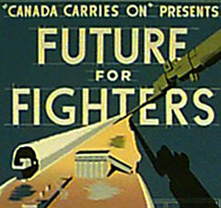
Poster for the film Future for Fighters in the series “Canada Carries On” (1944).
Source : Cinémathèque québécoise, 1988.1352.AF
-
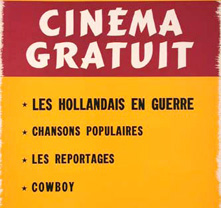
Poster announcing a free screening of NFB films.
Source : Cinémathèque québécoise, 2006.0183.AF
-

Musical score for the film C’est l’aviron (Norman McLaren, 1944) made for the series “Chants populaires”.
Source : Cinémathèque québécoise, 1992.0025.AN.01
-
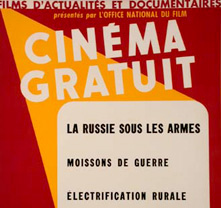
Poster announcing a free program of NFB newsreels and documentaries.
Source : Cinémathèque québécoise, 2006.0179.AF
-
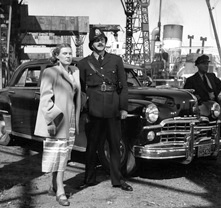
An image from the film L’homme aux oiseaux (Bernard Devlin and Jean Palardy, 1952).
Source : Cinémathèque québécoise 1999.0008.PH
-
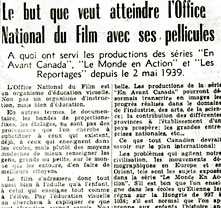
Le Canada, 21 March 1947, p.5.
Source : Bibliothèque et Archives nationale du Québec
-
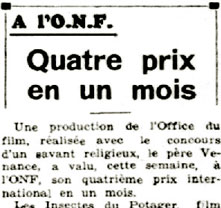
La Patrie, 21 septembre 1949, p.17
Source : Bibliothèque et Archives nationale du Québec
-
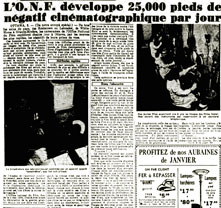
Le Petit Journal, 6 January 1946, p.7
Source : Bibliothèque et Archives nationale du Québec
In June 1938, the British producer John Grierson submitted his report on the Canadian government’s film activities and proposed that a national film board be created. This was done in May 1939 in Ottawa. Legislation granted it the mandate to “make and distribute films designed to help Canadians in all parts of Canada to understand the ways of living and the problems of Canadians in other parts”. Grierson, who was the NFB’s first commissioner, hired no French Canadians among the production personnel and it was not until 1942 that films began to be made in French, for a series called “Actualités canadiennes”, a newsmagazine for theatrical release produced by Vincent Paquette. This series soon changed its name to become “Les Reportages”. When it ceased production in 1946, 118 episodes had been filmed. Other series were also produced, including “Chants populaires”, animated films on which Norman McLaren, René Jodoin and Jean-Paul Ladouceur worked.
Grierson resigned as commissioner of the NFB in 1945, and his successor instigated cutbacks. The French crew was crushed but managed nevertheless to distinguish itself through films such as Montée (Raymond Garceau, 1949) and a few titles in the series “Vigie”, such as Saguenay (Roger Blais, 1947), Au parc Lafontaine (Pierre Petel, 1947), La Terre de Caïn (Pierre Petel, 1949) and Contrat de travail (Bernard Devlin, 1950). At the time, the Duplessis government was quarrelling with the NFB and had limited the distribution of its films in institutions which fell under its jurisdiction. The NFB then developed its own distribution channels through film councils or by working with commercial distributors. In 1950, the government adopted new legislation governing the NFB which included the now-famous mandate “to interpret Canada to Canadians and to other nations”. At the time, the situation of French-speaking filmmakers in the organisation was deplorable. The struggle to film the short fiction film L’homme aux oiseaux (Bernard Devlin and Jean Palardy, 1952) is a good illustration of the problem.
In the early 1950s, the NFB hoped to be granted responsibility for television. The Canadian Broadcasting Corporation, however, was given this task, and the NFB had to settle for some programming time. In 1953, a studio for the creation of French-language films was founded; its producer was Bernard Devlin. A second French-language studio soon followed, headed by Roger Blais. Among the material produced there were episodes in the series “Silhouettes canadiennes”. Television had considerable impact on the NFB’s output. After years of stagnation, nine people were hired, including Anne Hébert and Louis Portugais. While the reportages in the series “Sur le vif” (1954-55) were fairly disappointing, the series “Passe-Partout” (1955-56) had more interesting films, including Les aboiteaux (Roger Blais, 1955) and Alfred J. (Bernard Devlin, 1956). The series included classic documentaries, documentary-fiction hybrids and fiction films: in short, a remarkable range of styles. The arrival of television and the move to Montreal in 1956 were two major turning points in the history of the NFB.